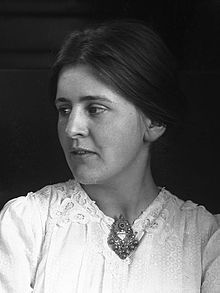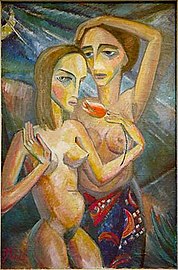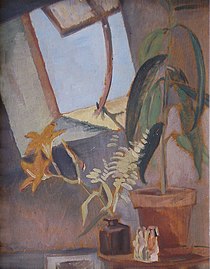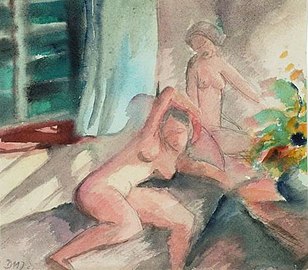| Dorothea Maetzel-Johannsen | |
|---|---|
 Dorothea Maetzel-Johannsen, 1910 Dorothea Maetzel-Johannsen, 1910 | |
| Born | Dorothea Johannsen (1886-02-06)February 6, 1886 Lensahn, Germany |
| Died | February 8, 1930(1930-02-08) (aged 44) Hamburg, Germany |
| Nationality | German |
| Known for | Painting |
| Movement | New Objectivity |
| Spouse |
Emil Maetzel (m. 1910) |
Dorothea Maetzel-Johannsen (6 February 1886 – 8 February 1930) was a German avant-garde painter.
Biography
Dorothea Johannsen was born in Lensahn. She went to Hamburg trade school for girls. She was a teacher in Schleswig until 1910 when she married the Hamburg architect and painter de:Emil Maetzel. As a married woman, she was no longer allowed to work as a teacher in the Wilhelminian Empire and had to give up the job.
She gave birth to four children: Ruth 1911, Bogumil 1913, Peter 1915, and Monika 1917.
Maetzel-Johannsen died in Hamburg on February 8, 1930, at the age of 44 years after an operation for heart weakness. A gravestone for Dorothea Maetzel-Johannsen and her husband is located in the Ohlsdorf cemetery, Planquadrat S 12 (near Chapel 1).
Career
Between 1911 and 1918 Maetzel-Johannsen traveled repeatedly to Berlin. During the First World War she took classes from Lovis Corinth. After the war, together with her husband, Maetzel-Johannsen was one of the co-founders of the Hamburg Secession.
In 1921, Maetzel-Johannsen moved into her own studio in Hamburg. Here works were made, in which she emphasized the surface effect of the paintings more strongly. At the same time she was concerned with the New Objectivity, which began to spread throughout Germany in the mid-1920s.
In 1923 she commissioned the painting for wall paintings in the Kunsthalle Hamburg. In 1925 she stayed in Paris and Chartres for six months. In France, she took a variety of new ideas for her work back to Germany, which should be used in the last five years of her work.
In 1930, Maetzel-Johannsen worked on a commissioned design for a ceiling painting in the Hamburg Planetarium, but she died before the design could be executed.
Exhibitions
- 1926 Joint exhibition with the sculptor Friedrich Wield, Hamburger Kunsthalle
- 1958 "Emil Maetzel - Dorothea Maetzel-Johannsen", Kunstverein Hamburg
- 2016 Community exhibition. Empathy and abstraction. The Modernity of Women in Germany; Bielefeld Arts Hall
Gallery
-
 Sitzender weiblicher Akt, 1913
Sitzender weiblicher Akt, 1913
-
 Drei Mädchen am Wasser, 1918
Drei Mädchen am Wasser, 1918
-
 Zwei Weibliche Akte, 1919
Zwei Weibliche Akte, 1919
-
 Das kranke Mädchen, 1919
Das kranke Mädchen, 1919
-
 Knabe mit rotem Ball, 1919
Knabe mit rotem Ball, 1919
-
 Schwertlilien und Kultgefäß, 1919
Schwertlilien und Kultgefäß, 1919
-
 Annemarie, 1920
Annemarie, 1920
-
 Zwei Mädchen mit Tulpe, 1921
Zwei Mädchen mit Tulpe, 1921
-
 Dachfenster, 1922
Dachfenster, 1922
-
 Maetzeljohannsen, 1922
Maetzeljohannsen, 1922
-
 Näherin, 1923
Näherin, 1923
-
 Interieur mit weiblichen Akten, 1925
Interieur mit weiblichen Akten, 1925
-
 Paris, Pont Neuf, 1925
Paris, Pont Neuf, 1925
-
 Sommerstrauß, 1927
Sommerstrauß, 1927
-
 Visby – Gelbe Bäume, 1929
Visby – Gelbe Bäume, 1929
See also
References
- "Dorothea Maetzel-Johannsen". Kuenstlerhaus Maetzel. Retrieved 21 September 2015.
- http://www.blouinartinfo.com/artists/dorothea-maetzel-johannsen-114621
- Some content is translated from the existing German Misplaced Pages article at de:Dorothea Maetzel-Johannsen; see its history for attribution.
This article about a German painter is a stub. You can help Misplaced Pages by expanding it. |